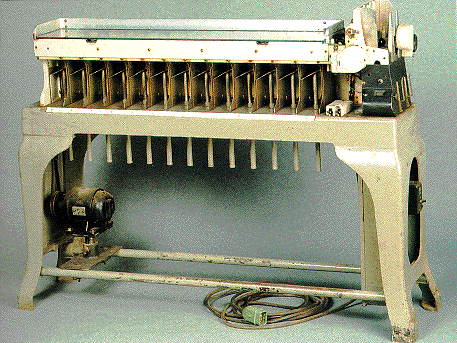Information and Technology in the Holocaust
Information and Technology in the Holocaust
 A Scheutz Calculating Engine
A Scheutz Calculating Engine
 The Hollerith Machine Produced by DEHOMAG, the Deutsche Hollerith Maschinen Gesellschaft, a subsidiary of IBM since 1922
The Hollerith Machine Produced by DEHOMAG, the Deutsche Hollerith Maschinen Gesellschaft, a subsidiary of IBM since 1922
Robert S. Leventhal
Copyright (c) 1995 by Robert S. Leventhal, all rights reserved. This text may be
shared in accordance with the fair-use provisions of the U.S. Copyright Law.
Redistribution or republication of this text on other terms, in any medium,
requires the written permission of the author.
"Everywhere we remain unfree and chained to technology, whether
we passionately affirm or deny it. But we are delivered over to it in the
worst way when we regard it as something neutral."
"What is dangerous is not technology [...] The essence of
technology is the danger."
Martin Heidegger, "The Question of Technology"
Vorträge und Aufsätze, 1954.
In the most recent research concerning the Nazi Genocide of the Jewish
Population of Europe, the role of technology and
information technology in
particular has been of particular interest. In the
United States Holocaust Memorial Museum in Washington, D.C., for example, a Hollerith machine, a
primitive calculating engine and precursor of the modern computer developed
by the statistician and census taker Herman Hollerith, is on display
as one of the mechanisms through which the Nazis were able to track the
Jewish populations and accumulate information regarding the "success" of
the Genocide.[1] The role of I.G. Farben and other industrial
corporations in the research and development of Zyklon B Gas and their complicity
in the formation of slave labor sites -- Buna at Auschwitz being perhaps
the most well-known of these -- has of course been common knowledge for many years.[2]
From these examples, it is clear that the Genocide of the European Jews 1933-45 was fundamentally indebted to the use of
technology, and that technology was not a peripheral or secondary medium, but
an absolutely essential medium for the execution of the so-called "Final
Solution" of the "Jewish Problem." The Nazi Genocide of the Jews of Europe was only possible
under the technological conditions of modern industrial culture, and in order
to truly understand that culture, we must learn about the technologies
themselves as well as the disciplines and institutions that developed and
supported those technologies. This "folder" is therefore itself divided into
four "files," each of which in turn consists of sub-files for the viewer to
browse or research.

Technologies Utilized by the Nazis in the Holocaust

Institutions and Corporations of Genocide

The Information of Death: The Hollerith Machine in Nazi Germany

Reflections on Technology, Mass Culture, and Genocide
Technologies Utilized by the Nazis in the Holocaust
During the Nuremberg Trials, I.G. Farben, one of
the largest chemical conglomerates of the world at that time, was charged with
crimes against peace, the plundering of occupied territories, partnership with a criminal group,
the SS, and the extensive use of slave labor. It is also well known that a
subsidiery of I.G. Farben produced the deadly Zyklon B Gas that was utilized in the Gas Chambers at Auschwitz, and that I.G.
Farben constructed and operated a factory and lab at Auschwitz, which had the
name Buna. Although I.G. Farben was not found guilty of
producing Zyklon B Gas with the intent that it be used to commit genocide, due to the fact that the management was told it was
being used for the treatment of delousing, the question as to the exact recognition of the I.G. Farben officials with
regard to the deadly gas is still an open question. While it is still unclear
to what exact extent I.G. Farben actually participated in the Genocide of
the Jews, we do know that I.G. Farben conducted experiments utilizing human
beings as subjects: Drugs against Typhus, sleeping pills, and nerve
poisonous gas were all administered under the aegis of I.G. Farben. It is also
clear that I.G. Farben colluded with the Extermination Camp statutes in the
treatment of prisoners. If a worker at Buna was found to be
weak, deficient, or disobedient, he or she was handed over to the SS and, in
most cases, brutally punished or murdered.
With regard to Science and Medicine under the Nazi Regime, the method up until very recently has been to focus on the scientists themselves instead of the institution of science. This is true of the early work of Alan Beyerchen, Scientists under Hitler, Alexander Mitscherlich and Fred Mielke, The Death Doctors, and, perhaps to a lesser extent, the work of Michael Kater.
In a now famous study of the Medical Profession under the Nazis, Robert
Jay Lifton's The Nazi Doctors has shown the
complicity of the entire field of medical science in the design, planning and
execution of medical experiments utilizing human beings in often horrifying and
brutally painful experimentation. It is above all the bio-medical sciences that
were useful to the Nazis in carrying out experiments on human subjects that were
deemed to be extremely dangerous or painful. Still, the image one gets from
Lifton's work, as compelling as it is, must be complemented with work concerning
the institutions and the organizations that overtly or covertly, implicitly or
explicitly colluded with these forms of human abuse and torture. Too often, both in popular culture and in film, the Nazi scientist is depicted as a deranged, marginal figure operating on the periphery of society and the state. This is the case with
many popular depictions of Mengele; the pathological rendering of
the Nazi dentist in Marathon Man is another case in point.
Elaine Scarry's brilliant study The Body in Pain
writes about this process as the "unmaking of a human world," and she is able
to show in this study the degree to which the very language of the experimentation
and the perpetrators devalued and destroyed the world of the victim
through a systematic rewriting of the human context of science and medicine.
The use of trucks with the Red Cross emblem on them is a good example of the
type of inversion and "unmaking of a world" that Scarry addresses in her work.
In another important study, Robert Proctor's
Racial Hygiene has traced the development
of theories of racial hygiene from the Pre-Nazi period to the progressive
entwinement between the medical sciences and the Nazi State. More recently, Mario Bagioli has written an institutional reflection
on the actual institutes, disciplines and academic Departments that colluded with the Nazi Genocide entitled Science,
Modernity, and the Final Solution in Saul Friedländer's volume Probing the Limits of
Representation. Here, it is not science gone awry, not the mad experimental scientist Mengele that comes into view, but the entire range of state
apparatuses, institutes, bureaucratic organizations and state mandated academic
Departments and their heads that signifies the unimaginable accomplishment of
the Nazi State. Biagioli has created an opening for the institutional and
disciplinary study of the complicity between science, technology and the Nazi Genocide.
Just to give a few examples, the
National Hygiene Department in the Ministry of the Interior and its head, Dr. Arthur Gütt,
were instrumental in the propagation of formulae and protocols for the "active
policy consistently aiming at the preservation of racial health."[3].
Or the Bureau for Enlightenment on
Population Policy and Racial Welfare, which, under the
leadership of Dr. Walter Gross, "spelled out the
practicalities of the racial policy." In these and other institutions,
eugenics and biology
were placed in the service of the National Socialist regime and its racist
policies. Konrad Lorenz, usually remembered as the founding
father of behaviourist theory, played a crucial role in the National Socialist assimilation of psychology when,
at the 16th Congress of the German Psychological Association
in 1938, he stressed his theory as a German psychology and
sought to demonstrate its usefulness for the goals of National Socialism.[4]
In Modernity and the Holocaust,
Zygmunt Bauman asserts that information technology was not
available at the time of the Nazi Genocide of the Jews: "information
technology (admittedly a recent development, not available at the time of the
Nazi Holocaust[...]" (115). Bauman quotes Joseph Weizenbaum,
who demonstrates in his book Computer Power and Human Reason
of 1976 that the genocidal capacity has, if anything, increased
since the development of such technology.[5] This runs parallel to the
critique of technology and instrumental reason leveled by Jacques Ellul in his book Technological System.
And yet it is well known that the Nazis did possess and make use of the proto-
type of the computer, a calculating engine called the Hollerith Machine, which,
having been developed from the punch card calculating engines of the third
quarter of the 19th century, could assist in the establishment of a database,
however rudimentary, that would track several variables regarding individuals,
groups, and cities, and therefore be instrumental in the maintenance of a
steady system of surveillance and control. The extent to
which such proto-computers were actually utilized in the Nazi Genocide should
be spelled out by a detailed study.
Notes
On Hollerith and his machine, see: Geoffrey D. Austrian,
Herman Hollerith: Forgotten Giant of Information Processing
(New York: Columbia University Press, 1982).Back
On I.G. Farben, and the role it
played in World War II and the Holocaust, see: Joseph Borkin, The Crime and Punishment of
I.G. Farben (New York: Free Press, 1978) and Peter Hayes, Industry and Ideology (New York: Cambridge
University Press, 1991).Back
Zygmunt Bauman, Modernity and the Holocaust (Ithaca:
Cornell, 1991), p. 115.Back
Theodora J. Kalikow, Die ethologische Theorie von Konrad Lorenz: Erklärung und Ideologie, 1938 bis 1943," Naturwissenschaft Technik und NS-Ideologie: Beiträge zur
Wissenschaftsgeschichte des Dritten Reichs (Frankfurt: Suhrkamp, 1980, 189-215.Back
Joseph Weizenbaum, Computer
Power and Human Reason: From Judgment to Calculation
(San Francisco: Freeman, 1976).Back
 The Hollerith Machine Produced by DEHOMAG, the Deutsche Hollerith Maschinen Gesellschaft, a subsidiary of IBM since 1922
The Hollerith Machine Produced by DEHOMAG, the Deutsche Hollerith Maschinen Gesellschaft, a subsidiary of IBM since 1922 A Scheutz Calculating Engine
A Scheutz Calculating Engine The Hollerith Machine Produced by DEHOMAG, the Deutsche Hollerith Maschinen Gesellschaft, a subsidiary of IBM since 1922
The Hollerith Machine Produced by DEHOMAG, the Deutsche Hollerith Maschinen Gesellschaft, a subsidiary of IBM since 1922



 Click here to go to a Bibliography of sources on science and technology in the Holocaust
Click here to go to a Bibliography of sources on science and technology in the Holocaust